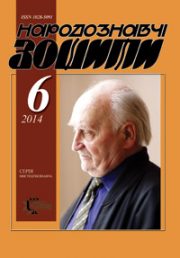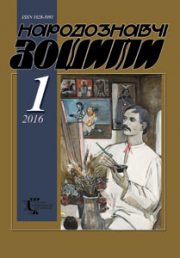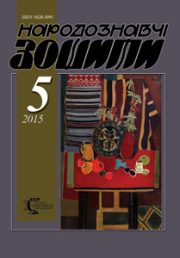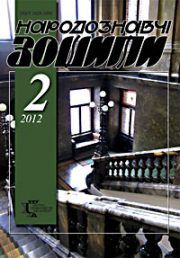The Ethnology Notebooks. 2020. № 1 (151), 138—146
UDK738.3.011.26(474.5-21)(06)
DOI https://doi.org/10.15407/nz2020.01.138
MOTYL Romana
ORCID ID: http://orcid.org/0000-0001-6936-0328
Candidate of Arts (Ph. D), Associate Professor,
Senior Researcher
Folk Art Department,
Ethnology Institute of NAS of Ukraine,
15, Svobody ave., 79000, Lviv, Ukraine,
Contacts: e-mail: romana_motyl@ukr.net
Abstract. The article highlights the experience of holding an International Ceramics Symposium in Leliūnai (Lithuania) and its contribution to the development of folk art. The problem of spiritual revival and enrichment of the present-day folk traditions is largely solved by symposium of ceramics, which became a striking phenomenon in the artistic space at the turn of the 20th—21st centuries. The study of the practice of holding this festival, the importance of its influence on the preservation, development and popularization of pottery traditions in today’s realities determine the relevance of this article.
Objectives: The purpose of the article is to explore, analyze and summarize the experience of holding an International Symposium in Leliūnai (Lithuania).
The scientific novelty of this article is that, on the basis of a comprehensive analysis, the basic concepts of holding a Symposium of Traditional Ceramics outside Ukraine (namely in Lithuania) were first generalized, systematized and structured, criteria for determining the types and content of the art created under the conditions of the symposium were developed; the influence of the symposium on the activation of the revival of pottery and the preservation of national traditions are outlined.
Results: An International Symposium on Traditional Ceramics in the Lithuanian town of Leliūnai (Utena district) is held on the basis of the Vytautas Museum of Ceramics. Representatives from Lithuania, Latvia, Ukraine and Japan came to the International Symposium, which took place on 18—26 August 2019. The art forms and images created by the masters turned out to be extremely diverse, but they were all united by one common feature — tradition. Each master, depending on his plan, used a decoration technique for the smoked ceramics production — polishing, dicing, cutting and more. The firing was carried out according to Lithuanian traditional technology of burning smoked ceramics — without air access. In general, the symposium participants created traditional products typical for their countries. Creative codes of symposium works mainly in ancient times, in ethnic culture, and they are universal and unique at the same time.
Conclusions: in general, this pottery symposium has a deep strategy. As a form of scientific and creative cooperation, it involves equal participation and communication of masters, art critics, organizers, curators, museum workers. The final exhibition of the works of the International Symposium of Traditional Ceramics testified to the high level of skill of representatives of all countries, and the deep cooperation of Ukrainian potters with foreign masters of folk art demonstrates the progressive entry of Ukrainian pottery into the world artistic space.
Keywords: Symposium, Leliūnai, pottery, ceramics, masters, pottery ware, form, decoration, traditions, art searches.
Received 3.01.2020
REFERENSES
Honchar, K.R. (2014). Ukrainian fine folklore in the modern cultural process: traditions and innovations: abstract of the dissertation for the degree of Candidate of Arts: 26.00.01. Kyiv [in Ukrainian].
Hudak, V., & Poshyvajlo, O. (Ed.). (2001). Ukrainian folk and professional ceramics as an integral part of the social factors of the revival of spirituality. Ukrainian Ceramology: National Yearbook (Vol. 1, pp. 162—173). Opishne: Ukrains’ke Narodoznavstvo [in Ukrainian].
Zinenko, T.M. (2013). The cultural model of symposiums of artistic ceramics in Ukraine as a phenomenon of modern culture. Ukrainian culture: past, present, ways of development (Issue 19 (2), pp. 301—306) [in Ukrainian].
Zinenko, T.M. (2014). The problematic field of symposiums of artistic ceramics in the system of scientific knowledge. Bulletin of Kharkiv State Academy of Design and Arts. Art Studies: a collection of scientific works, 2, 61—65. Kharkiv: KhDADM [in Ukrainian].
Zinenko, T.M. (2014). Symposiums of Artistic Ceramics of Ukraine of the late XX—the beginning of the XXI century as a phenomenon of modern culture: abstract of the dissertation for the degree of Candidate of Arts: 26.00.01. Kyiv [in Ukrainian].
Perets’, O.O. (2001). Art symposia as a means of becoming Poltava Art School. Ukrainian Ceramic Journal, 1, 16—18 [in Ukrainian].
Poshyvajlo, O. (Ed.). (2011). The second national exhibition-competition of ceramics «KeramPIK in Opishnе!» (July 2 — October 31, 2010): album catalog. Opishne: Ukrains’ke narodoznavstvo [in Ukrainian].
Poshyvajlo, O. (2001). Slavonic Ceramics Symposium 2001: Another Center for Creation of Pottery Culture in Ukraine. Ukrainian Ceramic Journal, 2, 63—98 [in Ukrainian].
Chehusova, Z., & Selivachov, M. (Ed.). (2006). Interaction and interplay of folk and professional creativity (on the example of the exhibition «Contemporary Decorative Art of Ukraine at UNESCO». Paris, May, 2004). Museums of Folk Art and National Culture: Collection of Works (Pp. 206—215). Kyiv: Zlatohraf [in Ukrainian].
Shevchenko, Yevhen. (Ed.). (2004). The first all-Ukrainian youth symposium on pottery art «Chygyryn-2003»: album catalog. Kyiv: Narodni dzherela [in Ukrainian].
Keramika Utenos Kraљte: album catalog. (2010). Utenos krastoturos muziejus [in Lithuanian].







